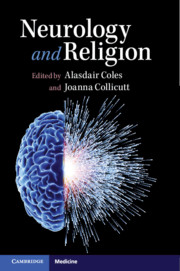Book contents
- Neurology and Religion
- Neurology and Religion
- Copyright page
- Contents
- Contributors
- Preface
- Part I The Neurological Study of Religion
- Part II Neurology and Religion
- II.I Clinical Conditions
- II.II Therapy
- Chapter 16 Religion and Spirituality in Neuro-Rehabilitation
- Chapter 17 Eastern Spirituality, Mind–Body Practices and Neuro-Rehabilitation
- II.III Death and the Brain
- Bibliography
- Index
- References
Chapter 16 - Religion and Spirituality in Neuro-Rehabilitation
A Case Study
from II.II - Therapy
Published online by Cambridge University Press: 28 October 2019
- Neurology and Religion
- Neurology and Religion
- Copyright page
- Contents
- Contributors
- Preface
- Part I The Neurological Study of Religion
- Part II Neurology and Religion
- II.I Clinical Conditions
- II.II Therapy
- Chapter 16 Religion and Spirituality in Neuro-Rehabilitation
- Chapter 17 Eastern Spirituality, Mind–Body Practices and Neuro-Rehabilitation
- II.III Death and the Brain
- Bibliography
- Index
- References
Summary
This chapter begins with a general consideration of the points where religion and spirituality connect with the enterprise of neuro-rehabilitation. This takes the form of a narrative that charts the chronological development of my ideas in the context of a field that is itself continually developing. It is followed by a case study of the rehabilitation of an individual with profound amnesia, whose faith was of overriding importance in his life. The case study both illustrates and elaborates several of the general themes raised in the earlier part of the chapter.
- Type
- Chapter
- Information
- Neurology and Religion , pp. 171 - 190Publisher: Cambridge University PressPrint publication year: 2019
References
- 1
- Cited by



